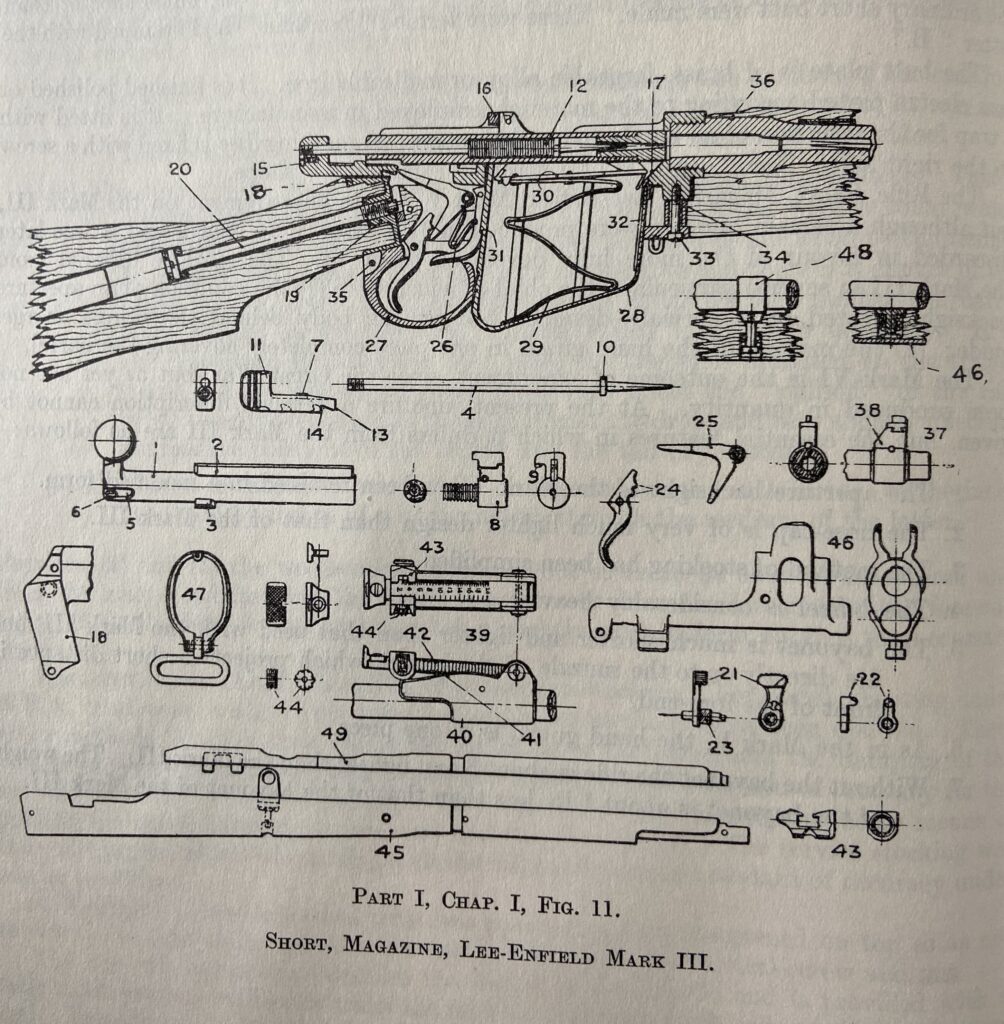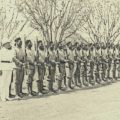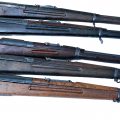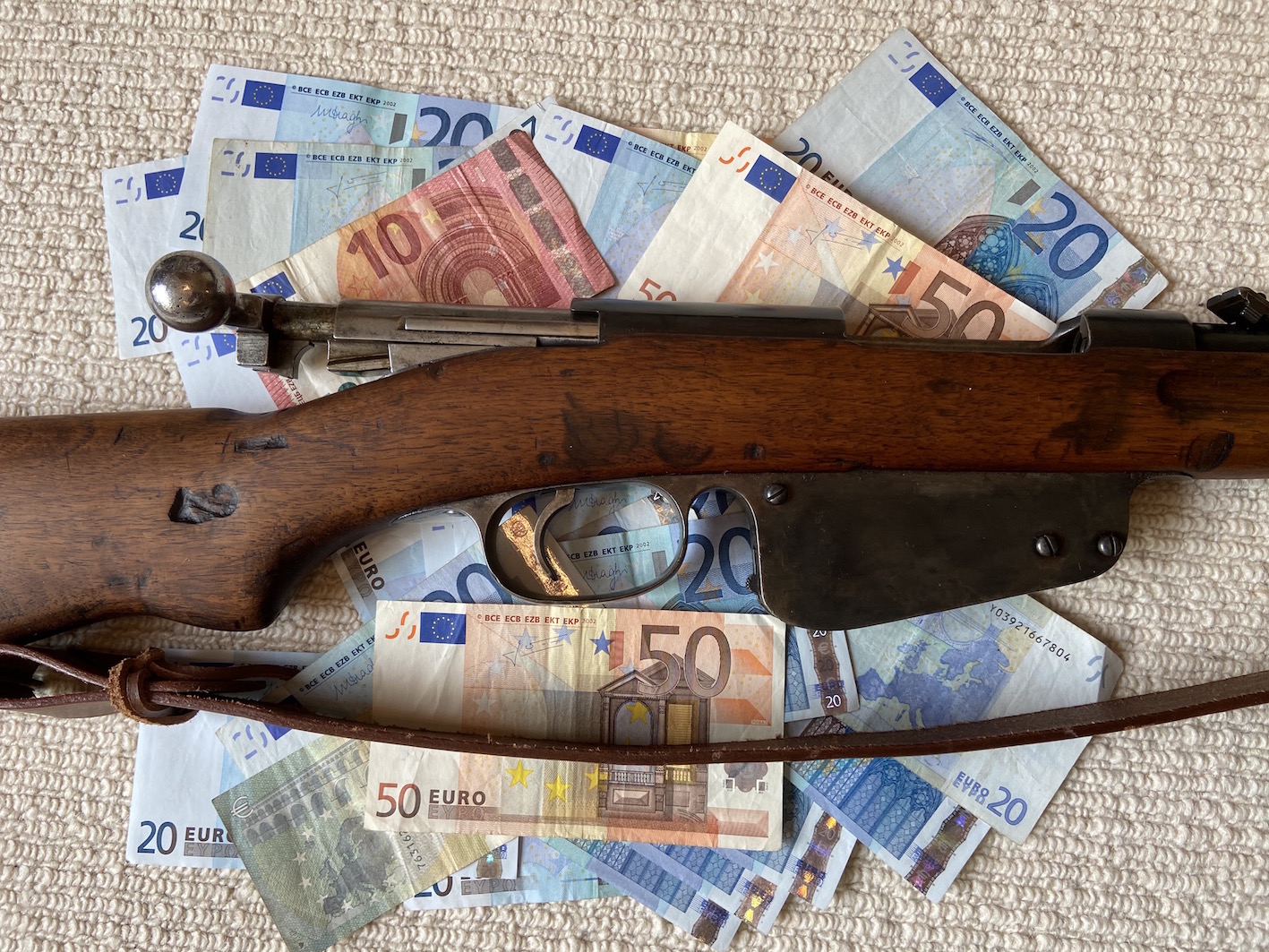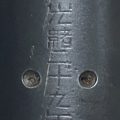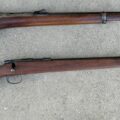Old rifles can be troublesome things to understand. Like all long-lived objects their meaning changes over time and what was once an expensive complex technological gamble, the failure of which could lead to defeat and death, becomes a more comfortable leisure accessory; a thing to be appreciated, studied and enjoyed with the comfort that only time and distance from original intent can provide.
I’d argue that few objects exemplify this shift in meaning better than the Rifle, Short, Magazine, Lee-Enfield, otherwise often known as the SMLE.
A Beloved Icon
It seems difficult to find any mention of the SMLE without seeing the word ‘iconic’ attached to it.
It’s easy to see why. Its unmistakable outline is there in almost every photograph of Empire troops in action during the Great War. There it is, defiant with fixed bayonet or lowered ‘on arms reversed’ as a mark of respect in the stone or metal hands of the soldiers and sailors perched on war memorials around the world. It even looks the part, being pugnacious and solid with its blunt nose cap. It could never be called pretty or elegant, but many believe it to be beautiful. It is a weapon for war, not parade grounds.
The adulation and respect this rifle now enjoys is expressed in many ways, from the constant arguments about its merits versus other weapons in the bear pit that is the internet to it being described as ‘beloved’ by one firearms author. It is no longer a mundane object. It has become almost mythical.
Informed Opinion: The Trade Journal ‘Arms and Explosives’
However, it’s important to understand that the rifle was seen in a very different light when it was first developed and issued. It was seen as a terrible mistake, fundamentally flawed in its concept and execution. Even the propellant used in its ammunition was seen as second best. The whole thing was an embarrassing failure that meant Britain was likely to go to war with a rifle that was seriously outclassed by its potential opponents.
These criticisms were particularly voiced by ‘informed opinion’. I want to focus on one occasionally well informed and always very opinionated source; the journal ‘Arms and Explosives’. Published in London between 1892 and 1920 it advertised itself as a ‘Technical and Trade Journal’. It offers a rare insight into what what was happening in the arms and other related trades at the time and what the concerns of its readership were.
Each issue is a mixture of serious technical instruction and lectures about the safe storage and use of explosives in industry and the fundamentals of weapons design including metallurgy and internal and external ballistics. There are also lists and explanations of new patents, company results, information about notable members and events in the trade and a fair amount of good old fashioned gossip, speculation and claims about this and that new weapon that hindsight tells us were absolute nonsense.
The writers for the journal were intensely patriotic but certainly not deferential to their ‘betters’. They consistently grumbled about the short sightedness and stupidity of government in general and the War Office in particular. Their main complaint was that decisions about something as important as military weapons were far too important to be left to soldiers. In 1913 the journal fulminated that the fundamental weakness holding back developments in military firearms was the ‘…lack of suitable early training…’ and the limited and parochial experience of those Army officers charged with the task. Worst of all, they said, was that ‘Outside help, from whatever source offered, is not utilised’. As far as the journalists were concerned what was really needed was the input of ‘experts’; particularly the ‘experts’ who wrote for ‘Arms and Explosives’.
“..so unsatisfactory and so unreliable”. The Wrong Propellant.
At the end of the Nineteenth Century the British Army, like all other armies, was forced to into an expensive and complex race to modernise its rifles. The forty odd years between the American Civil War and the turn of the century saw an extraordinary acceleration in the speed of change in firearms design after what had been a long period of stasis. The period saw a dizzying variety of innovations and ideas being tried and discarded, as armies attempted to take advantage of the opportunities afforded by reliable metallic cartridges and repeating magazine-fed firearms. Armies around the world were not only spending huge sums on reequipping their armies with new rifles but were also trying to ask and answer complex doctrinal and almost philosophical questions about how those rifles should used and what effect they might have.
The British search for such a weapon began in 1879, when the Board of Ordnance set up a committee to decide exactly what system should be adopted. The process was painstaking, with many different types being examined. It was perhaps a little too painstaking as it took until December 1888 before the solution was agreed upon; the ‘Magazine Rifle Mk1’. It was a combination of a bolt action designed by James Paris Lee and a barrel with rifling designed by William Metford, hence the name by which it’s better known; the ‘Lee-Metford’. Unfortunately, at least one component of the weapon system, the all important ammunition, was obsolete before it was even issued.
The next step change in military firearms technology happened in 1886 when the French army began to produce and test a hurriedly developed and somewhat clumsy rifle, commonly known as the Lebel’, to take advantage of the first effective smokeless propellant , ‘Poudre B’, developed by Paul Vieille. It’s hard to understate the horror this development engendered in the other nations of Europe. The French had achieved a technological masterstroke that gave their army a decisive advantage over every other army in the world.
These advantages were clear. The new powder produced higher velocity, allowing for a dramatic increase in effective range, and a flatter trajectory over a greater distance that meant it was easier for soldiers to hit what they aimed at. Their soldiers would be virtually invisible when they fired but they would be able to see the choking black powder smoke of their enemies, a smoke that not only betrayed positions but also rendered accurate marksmanship and the direction of troops almost impossible.
Unfortunately the Lee-Metford was designed around a cartridge filled with compressed black powder; indeed the shallow Metford style rifling of the weapon was partially intended to mitigate problems caused by black powder fouling. Giving the British soldier a black powder round in the new smokeless world would simply not do so the search began for a home grown substitute. An ‘Explosives Committee’ was set up to examine the question and in 1888 the decision was made to adopt a propellant based on a mixture of nitroglycerine, nitro-cellulose (in the form of guncotton) and Vaseline blended and gelatinised with the aid of acetone that was developed by Sir Frederick Abel, President of the Committee. The resultant mixture was then extruded through a die and takes the form of thin sticks or cords; hence the name ‘Cordite’. Cartridges filled with this propellant were first adopted in 1891.
For ‘Arms and Explosives’ this decision was incomprehensible and deeply suspicious. In their edition of February 1893 they reported on a lecture given in New York by Mr Duff Grant, British Secretary of the ‘Smokeless Powder Company’ in which Mr Grant stated unequivocally he’d heard from ‘Military men who know what is going on’ that Cordite was so ‘unsatisfactory’ and ‘unreliable’ that it was only a matter of time before it was replaced by the far better ‘Riflelite’ powder. He went on to make other claims, including that soldiers in shooting competitions regularly used ammunition loaded with Riflelite rather than Cordite ‘though they keep that to themselves’ and, most damning, that Cordite had only been adopted in the first place because of the ‘influence of Sir Fredrick Abel’.
The journal would not let the matter lie, and in October of the same year they were reporting on what they called the ‘Cordite Scandal’. In essence they argued that the Committee had exceeded their brief, ignored superior powders then available and had allowed two of its members to recommend that the military should adopt a propellant they had ‘invented’ and from which they would benefit financially through foreign patent rights. The journal then alleged with some circumspection ‘with respect of the Courts’ that Cordite was in fact not, in fact, a true invention, but merely an adaptation of a propellant called ‘Ballistite’ invented by Alfred Nobel, who was suing the Government for copyright infringement. All in all, the journal said this was an example of Government trampling on the rights of the inventor and that one day the ‘public may come to see to what an extent that system prejudices their interests’.
Riflelite never replaced Cordite in British service ammunition, but there was at least some truth in what the journal had to say. The major defect of Cordite, especially the first formulation, is that it burns with great heat. This excessive heat erodes barrels and wears them out far too quickly. Indeed, when Cordite ammunition was used in the Lee-Metford rifle barrels started to wear out and become inaccurate after as few as 2000 rounds had been fired instead of the 10,000 rounds expected. The solution came in 1895 with the adoption of a new barrel with rifling that had deeper, sharper edged grooves. This had also been conceived by William Metford but it was modified by the team at Enfield so his name disappeared from the rifle. With this modification the ‘Long’ Lee-Enfield rifle was born.
‘A Complete Revolution in the Art of Fighting Battles’. The Need for a Short Rifle.
The idea of a shortened, ‘universal’ rifle came about because some senior officers in the British Army recognised that the adoption of modern rifles meant that a revolution in military affairs had occurred. That revolution had changed war for good and could be summed up by three propositions:
Firstly, that infantry could no longer advance over open ground in closely formed bodies.
Secondly, that reconnaissance was more important than ever but would become much more difficult.
Thirdly, that there was a serious risk that without change the cavalry arm would become ineffective, or worse still, as ‘obsolete as the crusaders’.
The adoption of the SMLE would be one way that the cavalry could remain relevant on the modern battlefield.
One of these officers was Colonel G.F.R. Henderson (1854-1903). Henderson was a respected officer who had both the ear and friendship of Lord Roberts. ‘Bobs’ would write a long and fulsome introductory personal ‘Memoir’ to Henderson’s collection of essays ‘The Science of War’, first collected and published after his death in 1905. It was in these essays that Henderson’s views on the future of the cavalry were promulgated. He made it clear that the traditional method of employing horsemen in large tightly packed masses delivering what he called ‘shock effect’ by charging at the enemy with sword or lance was utterly outdated. The magazine rifle made such actions impossible, no matter how brave the trooper. He listed a pitiful few actions since the Napoleonic wars where such actions had even a minor effect on events and contrasted these with the many failures that occurred in the same period when ‘the cavalry dashed vainly…against the hail of a thin line of rifles’. His strongest criticism was directed at the continental armies who still maintained huge numbers of Cuirassiers and Lancers just as they did at the time of Waterloo but equally damning was his statement that the British cavalry in South Africa were ‘paralysed by the burden of effete traditions’. It wasn’t that the cavalry had ignored firearms; around the world they were armed with pistols or a carbine, a shorter type of rifle. The problem was that the carbine was a ‘popgun’, outranged by the rifles carried by the infantry. The cavalry could neither defend themselves or attack effectively on the modern battlefield.
Henderson believed that the answer to what seemed an intractable problem came from ‘across the Atlantic’. His studies of the American Civil War convinced him that ‘Cavalry trained to fight as Infantry and carrying a magazine rifle is the ideal arm’. To be sure, he believed that there could be no total elimination of ‘l’arme blanche’ as the sword was still seen as the best way to engage another group of cavalry, but for him the modern trooper would have to combine the élan and dash of old with the ability to use a rifle effectively. The problem was that the existing Lee-Enfield and Lee-Metford rifles were far too long and heavy to be used. If cavalry were to survive they would have to learn how to scout on the modern battlefield and would need a weapon more effective than the carbine but shorter, lighter, and handier than the rifle.
As well as these doctrinal considerations it had also been the case that the existing Lee-Metford and Lee-Enfield rifles used during the Second Boer War had not performed as well as had been hoped; the long rifle was unsuited to the quick ‘snap’ shooting required when facing an enemy adept at utilising cover and the sights on the rifles were incorrectly calibrated, leading to serious inaccuracy.
It was a combination of the belief that the existing rifle was flawed, plus the influence of Henderson’s ideas on Roberts that drove the development of the short rifle. What Roberts would champion would be a compromise. The infantry would get a better weapon and, more importantly, the cavalry would be saved.
‘The Improved Shortened Rifle’
On January 22nd 1900 the Director-General of Ordnance, Sir Henry Brackenbury (1837-1914) recommended that a new Small Arm Committee (SAC) be set up to first, address the issues of rifle accuracy and secondly to consider the question of the ‘Improved’ shortened rifle. What made this committee different from its predecessor was that, for the first time, it would include representatives of ‘the men who use the arms’ as well as manufacturers and inspectors. The soldiers would now have a say in the weapons they would take to war. Part of this process came in the form of a questionnaire sent to Regiments who had recently returned from South Africa. By January 1901 two patterns of short rifle were being examined. The first was developed by the Superintendent of the RSAF Enfield, Colonel HSS Watkins, while the second was a development of that rifle which incorporated developments made by the Committee. What was perhaps most telling was that the overall length of the rifle was determined not by the infantry, but by the cavalry. The minutes clearly state: ‘The Inspector-General of Cavalry intimated the greatest length that could be carried by a cavalry soldier and this weapon has been constructed accordingly’. Trials continued and by 1901 the committee could confidently state that Watkins rifle ‘possesses many advantages over the current Service rifle’ and was worthy of being produced in enough numbers to allow extensive troop trials.
By 15 December 1902, and after successful trials, the committee approved the short rifle and stated that it should be ‘recommended for manufacture’. However, the minute also reveals one of the challenges that the rifle would face in the future, namely the desire of the committee to constantly ‘tinker’ with the weapon. The Chief Inspector of Small Arms, Lieutenant-Colonel Hopton, recommended small changes to the sights. The changes were easily completed but the following week Lord Roberts grumbled to the Director-General of the Ordnance that these points should have been addressed long before this late stage and very pointedly said ‘I trust that the rifle as altered will be sealed not later than the 1st of January 1903’. It would have been a brave man who argued with ‘Bobs’ so the rifle pattern was indeed ‘sealed’ and the British Army got its new rifle.
‘He hoped the rifle would not be shortened’. Doomed from the Start.
Production of the SMLE was slow with only 961 being produced in the financial year April 1903 to March 1904. Production really took off the following year with 77,000 rifles coming out of RSAF Enfield and the BSA factory at Sparkbrook. Opinion was mostly favourable, but there were other voices in the military and especially in the influential target shooting fraternity who held very different ideas. ‘Arms and Explosives’ began to report on concerns that the new rifle was a failure. As early as June 1901 they reported on a debate in the House of Lords that mentioned the new rifle. Even though it was not yet a fixed design the journal made its opinion very clear when Lord Tweedmouth said that he ‘hoped the rifle would not be shortened’ and the journal stated that the Noble Lord had ‘struck the right note’. For his Lordship, and the journal, a short rifle would be less accurate at long range and more to the point new propellants to replace the hated Cordite would need long barrels to be efficient
However the main theme for the journal was one of mistrust and frustration. For them the War Office was blindly pursuing it aims without consulting the ‘experts’ from the gun trade. By 1902 things had got even worse. The first article on the front page of the August issue, titled ‘The New Service Rifle’ was a brief but excoriating criticism of everything about the weapon. The journal stated that the War Office was refusing to provide samples of the rifle for ‘informal examination and trial’ by the shooters at Bisley. This refusal infuriated them, claiming that such secrecy would mean that the rifle would not be seen by the ‘experts’ until it was out of the experimental stage, and then found to be so full of defects that it would have to go back to the drawing board. The most insulting accusation was that this would allow ‘Government officials and others’ to take out lucrative patents to remedy ‘defects that have no right to exist’. For the journal there was simply no excuse to even attempt to improve ‘so unpromising a weapon as the Lee-Enfield’. Lord Roberts himself came in for criticism and, in a fine piece of journalistic hyperbole, the journal said that even he could not convince them that the rifle was ‘one of the worst in existence’.
By 1903 the rifle was in limited service but the journals criticism continued. The February issue was particularly ill-natured. In a number of articles there were again grumbles that no-one had really seen the weapon because of the ‘absurd reticence’ of the Army but from what the journalists had heard the weapon was just an ‘improved’ Lee -Enfield and thus would likely retain the ‘faulty’ bolt mechanism and projecting magazine of the existing rifle. All in all the rifle ‘did not appear to rouse any great enthusiasm’. By August the criticism was more subtle. The journal had no desire to defend the new rifle with its ‘objectionable features’ but what they really objected to was that writers in the general press were criticising the wrong features of the weapon. Instead of focussing on the ‘radical defects’ of the old fashioned bolt action and two piece stock the papers seemed to care more about the increase in recoil that, it was asserted, would be the result of reducing the weight and length of the weapon. The journal poured scorn on this assertion (though they had made it themselves the previous month) and concluded, again, that the only people worth taking notice of were themselves. Indeed the final part of the article expands this belief and states that no rifle would succeed if it was designed by a body as flawed as the Small Arms Committee where there was an ‘entire absence’ of the all important knowledge of ‘the technicalities of rifle science’ and the ‘minutiae of mechanical workshop practice’. Given such a spectacularly condescending attitude it’s hardly surprising that the War Office felt no desire to provide the journal with any help or access to the rifle.
By 1912 the journal regarded the rifle as a hopeless case and they reported a debate in the Commons under the damning headline ‘Responsibility for the defects of the Service Rifle’. They put the blame firmly on Lord Haldane who had made a ‘tremendous blunder’ by wasting time in researching automatic weapons while the Army still had an ‘inferior’ bolt-action rifle. The SMLE was simply a mistake, developed by a Committee too stupid and hidebound to listen to what ‘competent and experienced outside experts’ had to say.
Wartime.
The British Army went to war with the rifle they had rather than the rifle they wanted. It’s worth looking at how “Arms and Explosives’ reacted to what they rather oddly called ‘The Biggest Disturbance of Living or other (sic) Memory’.What’s notable is the mix of prescience and incomprehension that the journal displayed in its September 1914 issue. Firstly, it believed that the rifle, not machine guns or artillery would be the decisive weapon of the war and secondly, that the British would fight a more modern war than their old fashioned allies and enemies. The Germans might have many more men but they would come on in a ‘stolid, undeviating advance…’ whereas the British Army had now learned how to shoot well from improvised cover and keep their own casualties low while inflicting ‘destructive’ losses on the closely packed mass formations of the enemy. As for the French, though they had shown great élan in their ‘brilliant’ bayonet charges, they did not apply the ‘correct’ use of rifle fire to create the ‘demoralisation’ that made such charges ‘profitable’. Very sensibly it concluded that ‘Bravery unadulterated with caution does not suit modern conditions’.
The Final Verdict: Grudging Respect.
As the war dragged on the journal rarely mentioned the SMLE, concentrating mostly on the effect of war on the trade and particularly the shortages of men and materials. However in September 1916 a small piece on the replacement of the troublesome Canadian Ross rifle with the SMLE included an extraordinary change of opinion about a rifle that had been despised just a few years earlier. The journal couldn’t resist pointing out that the design was ‘far from being perfect’ but that it was ideally suited to the ‘circumscribed’ conditions of the trenches because of its short length and that the ease of manipulation of its bolt action allowed a rate of fire with which ‘no other military small-arm can compete’. The article concluded with a statement that would have been unthinkable in 1912: that the SMLE was ‘the best weapon employed in the war by any belligerent’. This is one of the moments when the ‘legend’ of the SMLE began to emerge.
Conclusion: The Problems of Prediction.
‘Arms and Explosives’ survived the war but not the peace. By 1920 the cost of printing had increased by three and a half times compared to 1914 but that was not why it ceased publication. The main reason, according to the editor, was that the world had changed so much that the paper had simply ‘lived to the full limit of its powers of usefulness’. In particular the editor believed he had witnessed a complete collapse in the development of military firearms. In the past this had been ‘an actively progressing science’ but was now ‘moribund’. As such, that was the point in continuing?
These statements speak more of ennui than analysis, but they symbolise the essential weakness of the journal; its reporting was mostly second hand accretions of gossip and recycled foreign journal pieces and newspaper reports. Any original ‘investigative’ work was fatally flawed because the journalists could never get the access to the decision making process that they thought their ‘expertise’ deserved. That meant their opinions were always tinged with the resentment that comes when ‘mere tradesmen’ are fobbed off by the great and good. The journal remains entertaining to read, full of opinions and useful trade information but a contemporary business using it as a predictor of future trends would mostly be very disappointed.
As for the SMLE, their opinion of the rifle we now call ‘iconic’ changed from outright derision to grudging respect when it was used in a war that it was not designed for but turned out to be ideally suited to win.
Thanks
A version of this piece first appeared in “Stand To’, the Journal of the Western Front Association. The association has branches around the world and membership is highly recommended. Check them out at:
https://www.westernfrontassociation.com
I am particularly indebted to Richard Fisher at the Vickers MG Collection and Research Association who not only scanned the many thousands of pages of the Small Arms Committee and Munitions Design Committee minutes and Ordnance Board memoranda from 1900 to 1939 but also provided a comprehensive index to them. This extraordinary primary resource is available to Patrons of the Association for a small monthly fee. If you have any interest in military history I strongly recommend supporting their valuable work.
https://www.patreon.com/vickersmg/membership
Arms and Explosives journal is available online at then Centre for Research Libraries
https://dds.crl.edu/crldelivery/28565
Interested in Military Rifles and the Arms Trade of the late Nineteenth Century. Loves the smell of archives in the morning.
